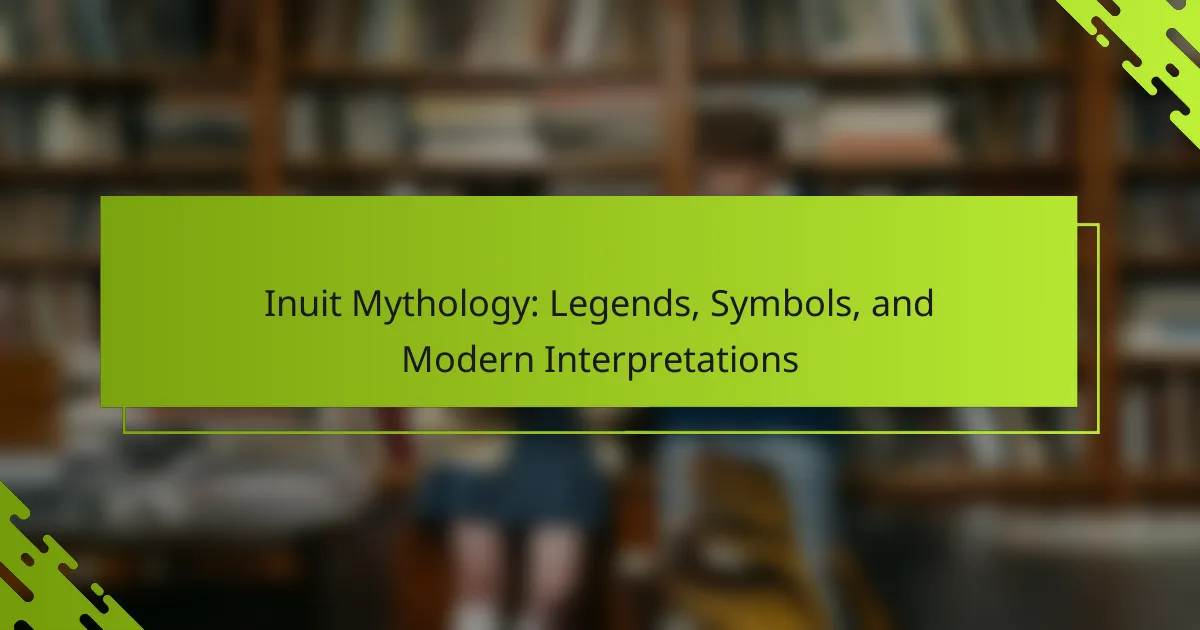Inuit mythology offers profound insights into the natural world and human existence through its legends and symbols. This article explores key figures like Sedna and Nanook, the cultural significance of symbols such as the Inukshuk, and modern interpretations that connect these ancient narratives to contemporary issues like climate change and identity. Understanding these elements highlights the resilience of Inuit culture and its ongoing relevance in today’s society.
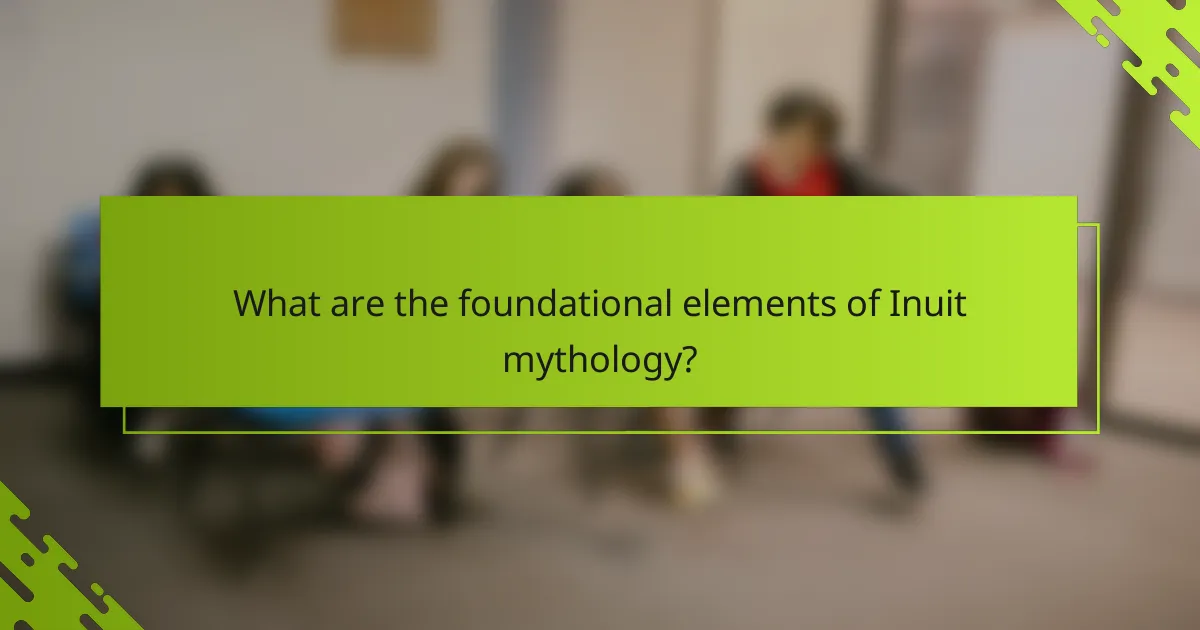
What are the foundational elements of Inuit mythology?
Inuit mythology consists of foundational elements such as creation stories, deities, and cultural symbols. These narratives explain the natural world and human existence. Key figures include Sedna, the sea goddess, and the trickster figure, Raven. Symbols like the Inukshuk represent guidance and community. Modern interpretations often connect these myths to contemporary environmental issues, highlighting their relevance today.
How do creation myths shape Inuit cultural identity?
Creation myths significantly influence Inuit cultural identity by providing a framework for understanding the world. These myths convey values, traditions, and social norms that shape community bonds. For example, stories about the land and animals emphasize respect for nature, reinforcing sustainable practices. Additionally, these narratives foster a sense of belonging and continuity among Inuit people, connecting past generations with the present. The unique attribute of Inuit creation myths lies in their oral tradition, which allows for adaptations that reflect contemporary issues while preserving core beliefs.
What role do nature and the environment play in Inuit legends?
Nature and the environment are central to Inuit legends, influencing their themes and characters. These legends often reflect the harsh Arctic landscape, showcasing animals and natural phenomena as vital elements. For example, the sun and moon are personified, embodying the balance of life. The legends also emphasize respect for nature, highlighting the interconnectedness of humans and their environment. This relationship fosters a deep cultural understanding of survival and harmony within the ecosystem. Inuit mythology serves as a guide, teaching lessons about adaptation and respect for the natural world.
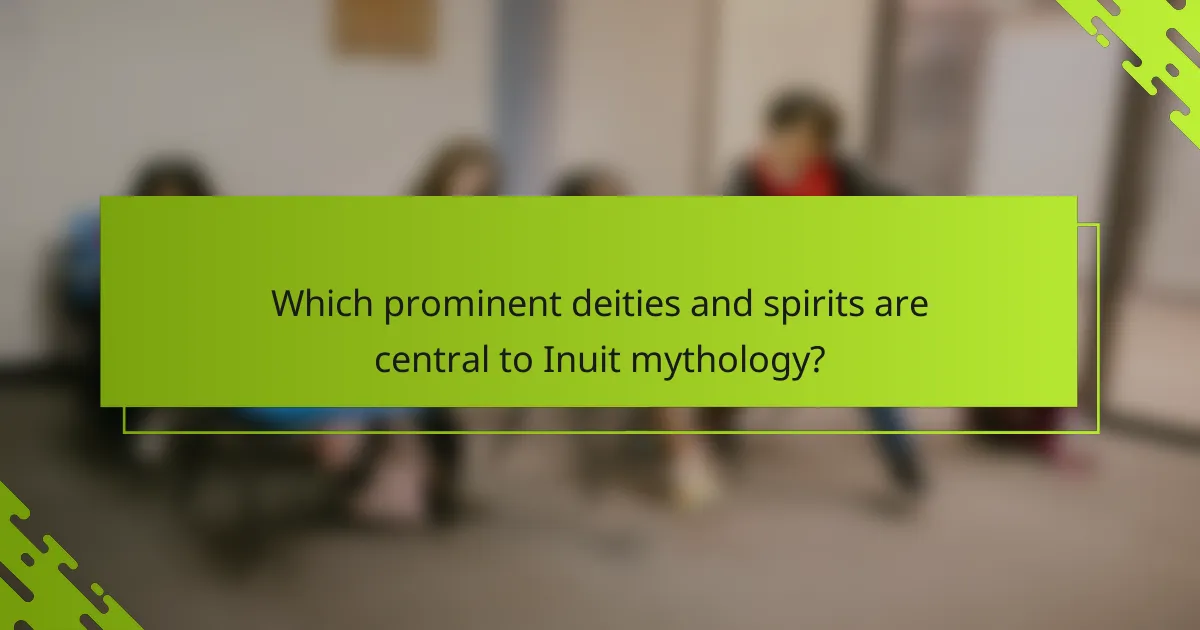
Which prominent deities and spirits are central to Inuit mythology?
Prominent deities and spirits central to Inuit mythology include Sedna, the goddess of the sea and marine animals, and the sun goddess, who represents life and warmth. Other significant figures are the trickster spirit Nanook and the creator god, who shaped the world. Each entity plays a vital role in the Inuit understanding of nature and survival. Sedna, unique for her connection to the ocean, embodies themes of life, death, and rebirth, while Nanook symbolizes the balance between humans and the animal kingdom.
How do the characteristics of Sedna influence Inuit beliefs and practices?
The characteristics of Sedna significantly influence Inuit beliefs and practices by embodying themes of survival, respect for nature, and the interconnectedness of life. Sedna is viewed as the goddess of the sea and marine animals, reflecting the Inuit’s reliance on these resources for sustenance. Her story emphasizes the importance of balance in the natural world, guiding hunting practices and spiritual rituals. Additionally, Sedna’s unique attribute as a protector of sea creatures shapes Inuit ethical perspectives on conservation and the treatment of animals. As a result, her influence permeates traditional ceremonies and modern interpretations of Inuit identity and culture.
What is the significance of the Sun and Moon in Inuit cosmology?
The Sun and Moon hold immense significance in Inuit cosmology, representing essential elements of life and balance. The Sun symbolizes warmth, growth, and sustenance, while the Moon embodies the cyclical nature of time, guiding hunting and seasonal activities. Together, they illustrate the Inuit understanding of harmony within the natural world and the importance of celestial bodies in their cultural practices. The duality of light and darkness reflected in their movements influences various aspects of Inuit life, including spirituality and storytelling.
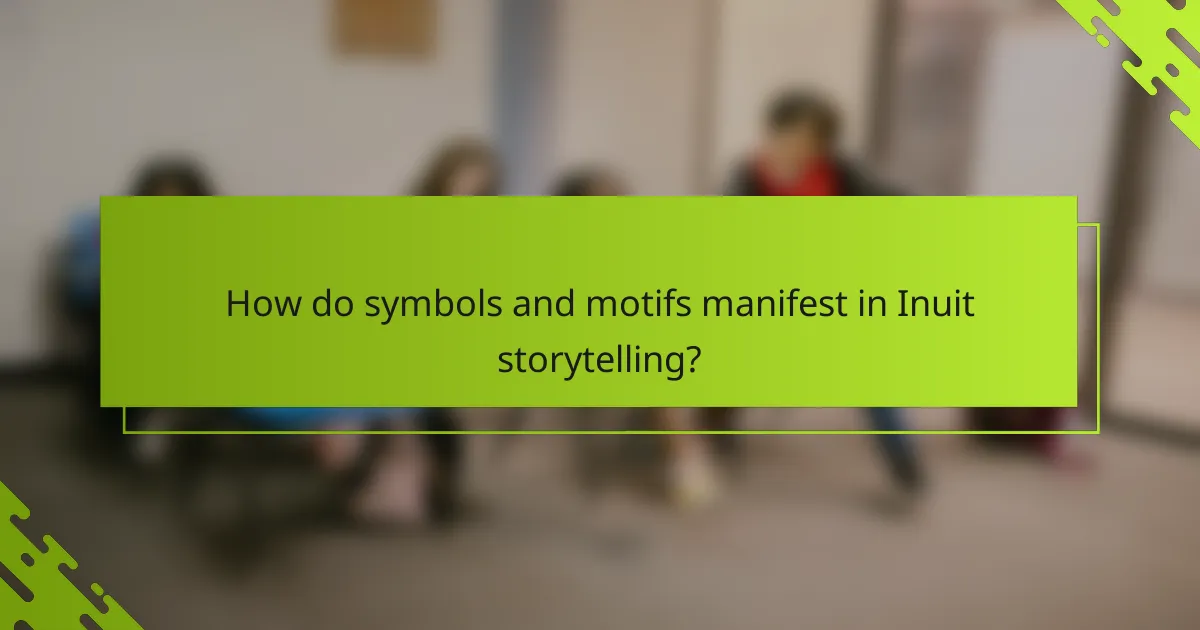
How do symbols and motifs manifest in Inuit storytelling?
Symbols and motifs in Inuit storytelling manifest as essential elements that convey cultural values and beliefs. They often represent natural elements, animals, and spiritual concepts, illustrating the interconnectedness of life and the environment. For example, the raven symbolizes transformation and creation, while the seal represents sustenance and survival. These motifs serve not only as narrative devices but also as tools for teaching moral lessons and preserving history. Additionally, modern interpretations of Inuit storytelling continue to reflect these symbols, adapting them to contemporary contexts while maintaining their cultural significance.
What are the common themes found in Inuit myths?
Inuit myths commonly explore themes of nature, survival, and the relationship between humans and the environment. These legends emphasize the importance of animals, spirits, and the interconnectedness of all living things. Additionally, they often reflect cultural values, such as respect for the land and the significance of community. Myths also serve as moral lessons, illustrating the consequences of actions and the need for harmony.
How do animals symbolize various traits and lessons in Inuit legends?
Animals in Inuit legends symbolize various traits and lessons, often reflecting the relationship between nature and humanity. For instance, the raven represents transformation and adaptability, while the wolf embodies loyalty and teamwork. These symbols convey moral teachings, emphasizing respect for the environment and community values. Inuit mythology uses these animal representations to impart wisdom and cultural identity, fostering a deeper understanding of life and survival in the Arctic.
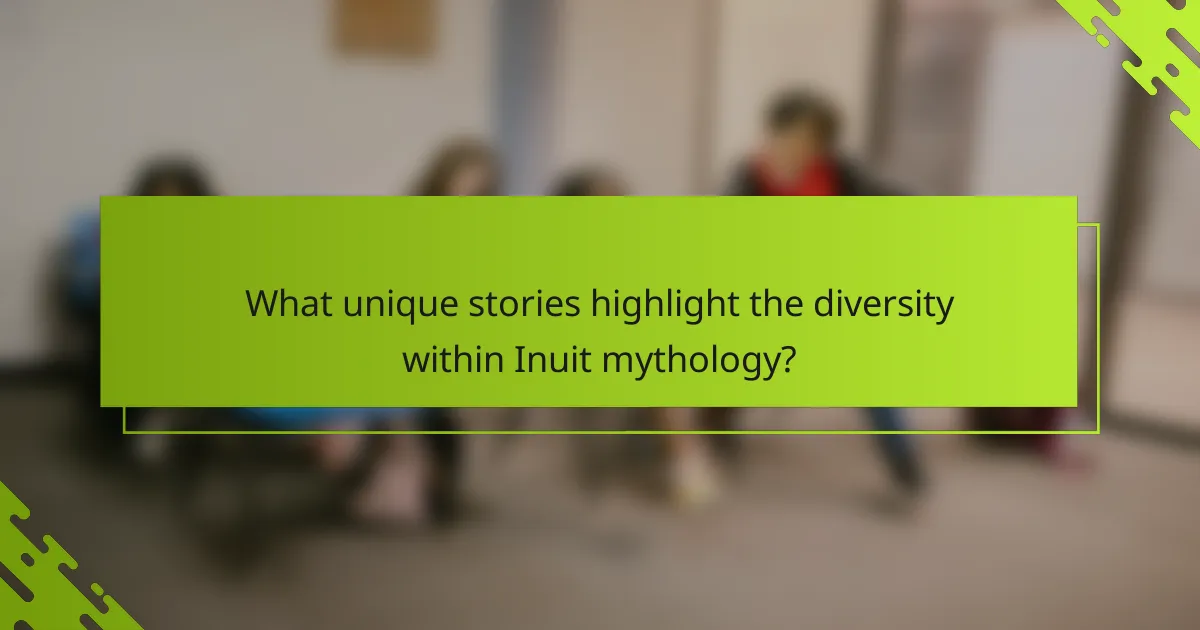
What unique stories highlight the diversity within Inuit mythology?
Inuit mythology showcases diverse stories that reflect the culture’s values and beliefs. Unique tales, such as the story of Sedna, the sea goddess, highlight the Inuit connection to nature and the importance of marine life. Another notable legend is that of the trickster figure, Nanook, who embodies the complexities of survival and morality in harsh environments. These narratives often feature rare attributes, such as the blending of human and animal characteristics, emphasizing the interconnectedness of all beings. Modern interpretations of these myths continue to evolve, showcasing their relevance in contemporary discussions about identity and climate change.
How do regional variations influence mythological narratives?
Regional variations significantly shape Inuit mythology by influencing legends, symbols, and modern interpretations. Diverse environments lead to unique narratives that reflect local experiences and cultural practices. For instance, coastal Inuit may emphasize sea creatures, while inland groups might focus on terrestrial beings. These variations enrich the mythology, allowing it to adapt to different contexts and resonate with specific communities. Additionally, modern interpretations often draw from these regional differences, creating a dynamic interplay between tradition and contemporary understanding.
What are some lesser-known Inuit legends that offer unique insights?
Inuit mythology features many lesser-known legends that provide unique insights into their culture and worldview. One such legend is that of the “Moon and Sun,” which explains the balance between light and darkness, symbolizing the harmony in nature. Another is the tale of “Sedna,” the sea goddess, who embodies the connection between humans and the marine environment, emphasizing respect for nature. The story of “Kiviuq,” a wandering hero, showcases resilience and adaptability, reflecting the Inuit spirit. These legends reveal values of harmony, respect, and survival, integral to Inuit identity.
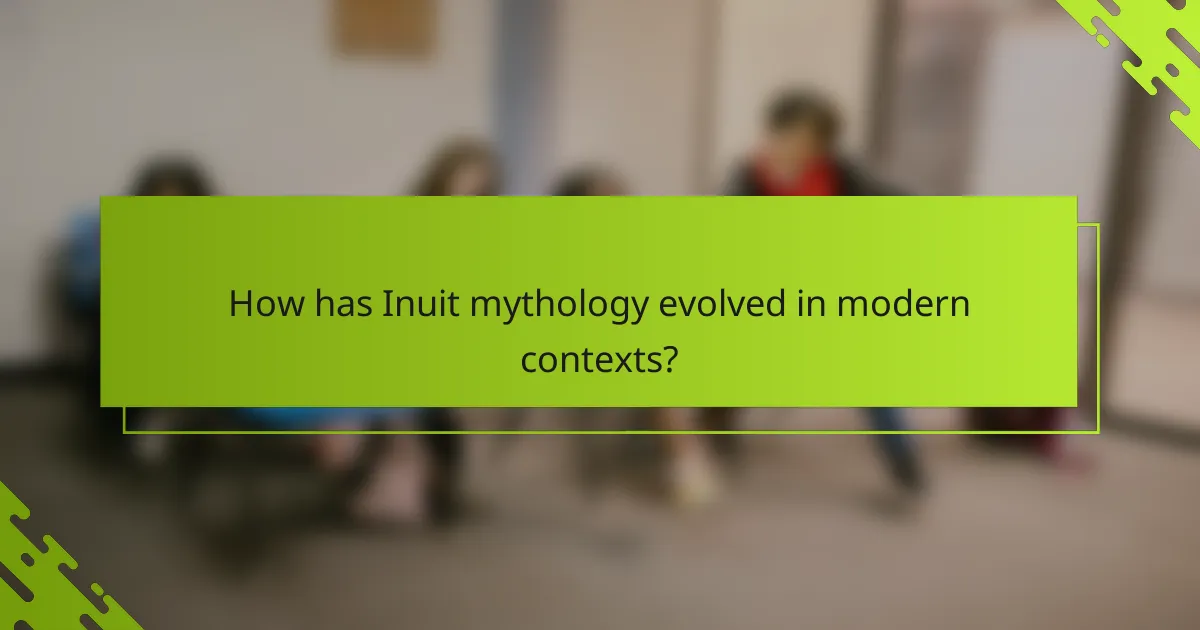
How has Inuit mythology evolved in modern contexts?
Inuit mythology has adapted significantly in modern contexts, blending traditional beliefs with contemporary issues. This evolution reflects the resilience of Inuit culture and its ability to address modern themes such as identity, environmentalism, and social justice.
For example, traditional stories now often incorporate modern elements, resonating with younger generations. Artists and writers reinterpret myths through various mediums, creating a dialogue between the past and present.
Additionally, Inuit mythology plays a role in cultural revitalization efforts, emphasizing the importance of storytelling in maintaining cultural heritage. This shift has led to increased awareness and appreciation of Inuit narratives within broader Canadian and global cultures.
Overall, the evolution of Inuit mythology demonstrates its relevance and adaptability, ensuring its continued significance in contemporary society.
What role does Inuit mythology play in contemporary art and literature?
Inuit mythology significantly influences contemporary art and literature by providing cultural narratives and symbols. Artists and writers draw on these myths to explore identity, connection to nature, and community values. For example, the figure of the trickster, often represented in Inuit tales, appears in modern storytelling to challenge social norms. This integration of traditional elements fosters a dialogue between past and present, enriching contemporary expressions. Additionally, unique attributes of Inuit mythology, such as the emphasis on harmony with the environment, resonate strongly in today’s discussions on sustainability and cultural preservation.
How are traditional stories being preserved and adapted in modern media?
Traditional stories are preserved and adapted in modern media through various creative expressions. Inuit mythology is increasingly represented in films, literature, and digital platforms, allowing broader audiences to connect with these ancient narratives.
Modern adaptations often emphasize core legends and symbols, such as the significance of the raven or the creation stories. For example, animated films and graphic novels reinterpret these myths, making them accessible to younger generations.
Furthermore, contemporary artists and storytellers infuse traditional tales with modern themes, addressing issues like climate change and cultural identity. This approach not only honors the original stories but also ensures their relevance in today’s society.
Social media plays a crucial role in this preservation effort, with platforms facilitating the sharing of Inuit stories and symbols. As a result, these narratives continue to thrive and evolve, bridging the past with the present.
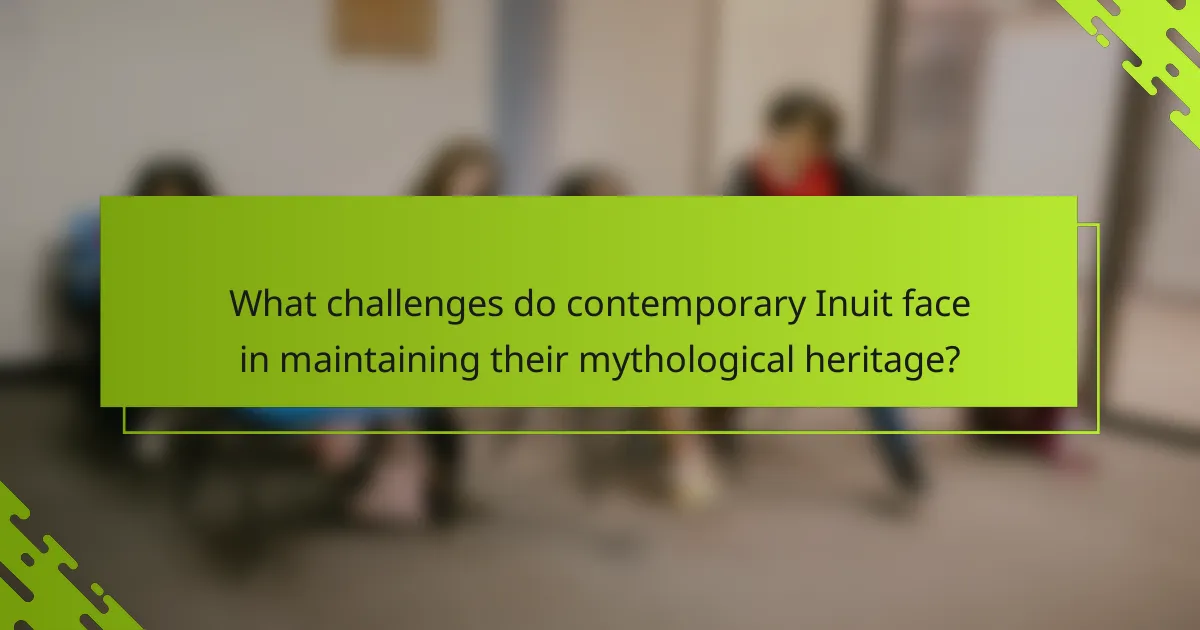
What challenges do contemporary Inuit face in maintaining their mythological heritage?
Contemporary Inuit face significant challenges in maintaining their mythological heritage due to modernization, climate change, and cultural assimilation. Rapid urbanization and technology impact traditional storytelling practices.
Inuit mythology, rich in symbolism and meaning, struggles to find relevance among younger generations influenced by global culture. The loss of language also threatens the transmission of myths.
Climate change alters the natural landscapes central to many legends, diminishing their cultural significance. As traditional practices decline, the community risks losing unique attributes of their heritage.
Efforts to revitalize interest in Inuit mythology include educational programs and cultural initiatives that encourage storytelling and the preservation of oral traditions. These initiatives aim to strengthen connections to their roots and ensure the survival of their unique identity.
How do globalization and cultural exchange impact Inuit storytelling?
Globalization and cultural exchange enrich Inuit storytelling by introducing new themes and perspectives while preserving traditional narratives. Modern interpretations often blend ancient myths with contemporary issues, creating relevance for younger generations. This dynamic fosters a unique cultural dialogue, allowing Inuit stories to evolve without losing their core identity. As a result, storytelling remains a vital part of Inuit culture, bridging past and present.
What efforts are being made to revitalize Inuit mythology among younger generations?
Efforts to revitalize Inuit mythology among younger generations include educational programs, community storytelling events, and digital platforms. These initiatives aim to engage youth with traditional legends and symbols while fostering cultural pride. For example, local schools incorporate Inuit stories into their curricula, enhancing cultural awareness. Additionally, social media campaigns highlight modern interpretations of myths, making them accessible and relatable. These combined efforts help preserve the unique attributes of Inuit mythology, ensuring its relevance for future generations.
What best practices can be adopted to respect and promote Inuit mythology?
Respecting and promoting Inuit mythology involves engaging with its narratives and symbols authentically. Incorporate traditional stories into educational programs to foster understanding. Collaborate with Inuit communities to ensure accurate representation. Support artistic expressions that reflect Inuit beliefs, such as visual arts or performances. Encourage respectful storytelling that honors cultural significance. Advocate for the preservation of languages and oral traditions that convey these myths, ensuring they remain vibrant for future generations.
